Yarrow is a beneficial flowering herb that that grows in many different places throughout the world. All varieties of yarrow can be grown and dried for tea. Learn how to dry yarrow for tea, and preserve your harvest to use throughout the year.
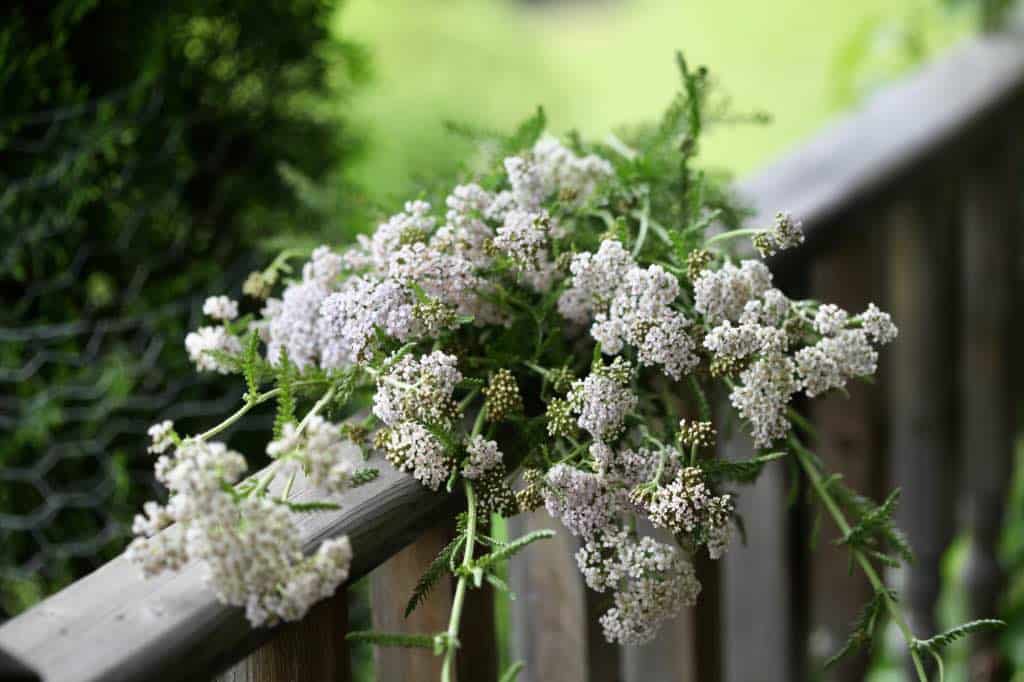
Yarrow, also known by the genus name Achillea, is a member of the Asteraceae (Compositae) Family. There are approximately 130 species of Achillea distributed throughout Europe, Asia, and North America.
When I first discovered yarrow, it was wild yarrow growing as a wildflower in my own backyard.
Since then I have also grown yarrow in the garden, including cultivated varieties to use as cut flowers. These varieties are often larger and fuller than the wildflower yarrow, with large disc shaped flower heads with muted romantic colors.
Not only can yarrow be dried for tea and herbal use, you can also dry yarrow for flower arrangements.
There are many different varieties of yarrow. All varieties can be grown for herbal use.
Both the leaves and the flowers of yarrow can be used, and can be consumed fresh or dry.
Yarrow is easy to dry and preserve. The great thing about preserving these plants is that once dried, you have them on hand to use throughout the year.
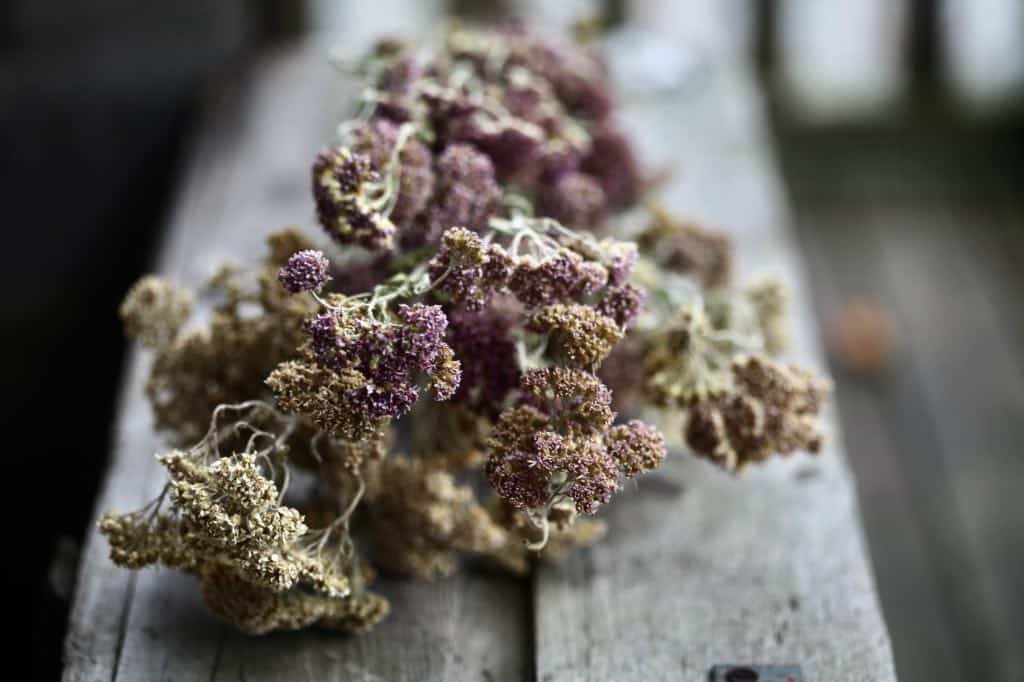
Why Dry Yarrow For Tea?
Although yarrow can be used in both the fresh and dried form for tea, drying the herb for tea will allow you to use the plant for tea throughout all the seasons.
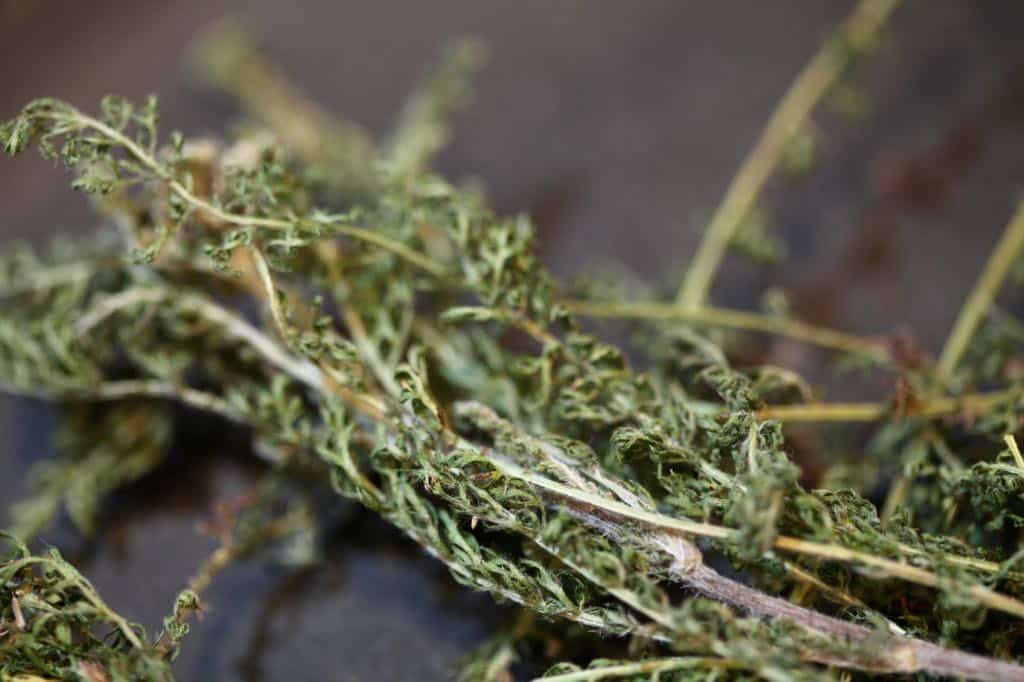
The Benefits Of Yarrow Tea
Since ancient times yarrow has been used traditionally as a medicinal herb with beneficial properties.
For a more in-depth review of yarrow's phytochemistry and medicinal properties, have a look at this article from the National Library Of Medicine and PubMed Central: A review on phytochemistry and medicinal properties of the genus Achillea.
This useful herb has been used readily in folk medicine to treat wounds, inflammation, pain, spasmodic conditions, as well as certain gastric disorders.
The scientific study of various Achillea species has revealed the presence of active metabolites such as flavonoids, phenolic acids, different terpenoids, coumarins, and sterols. The plants can also have estrogenic effects.
Yarrow tea has been reported to help fight bacteria and viruses, reduce pain, and aide in digestion. It has also been reported to stimulate diaphoresis or sweating, which can help with fevers.
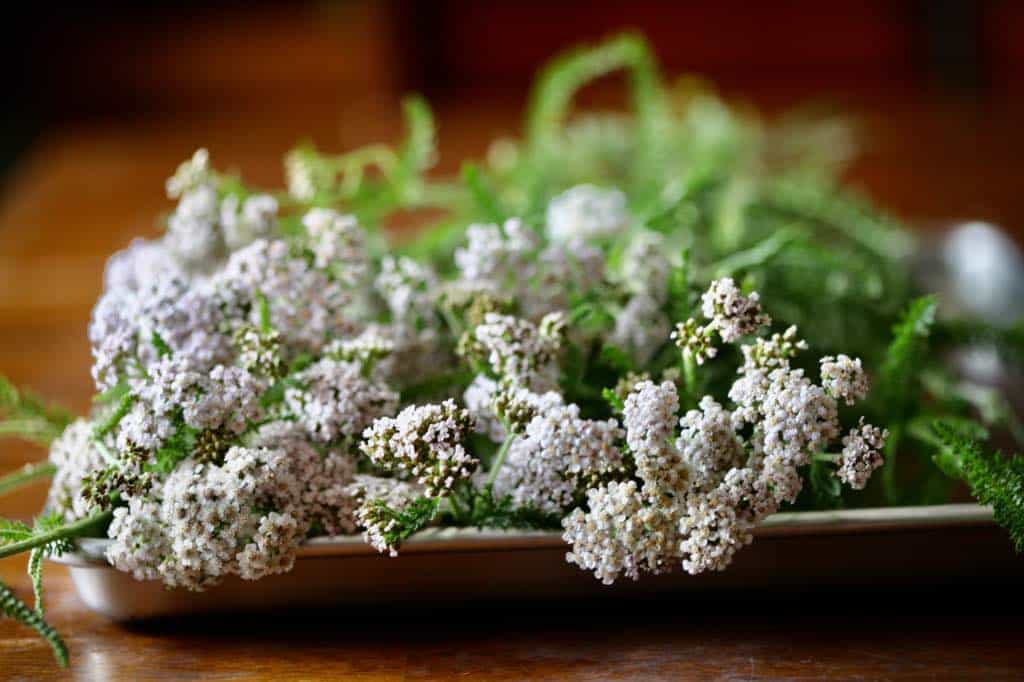
Who Should Not Use Yarrow Tea
As with any herbal teas, these beverages should be used with discretion.
Anyone who has had an allergic reaction to plants in the Asteraceae family should avoid yarrow tea.
Due to possible estrogenic effects, yarrow tea should also be avoided by breast feeding and pregnant women.
Always check with your doctor if you are on prescription medication before consuming medicinal plants and herbal teas, due to possible drug interactions.
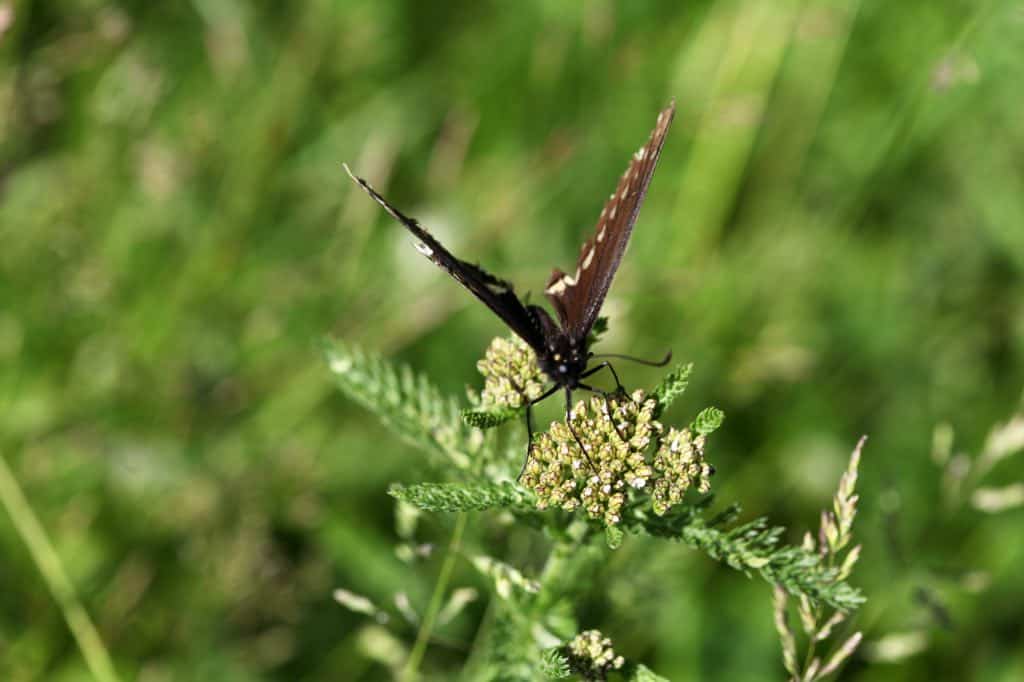
How To Dry Yarrow For Tea
Identifying Yarrow
- Yarrow is also known as achillea millefolium, meaning a thousand leaves. Recognizing the leaves is key to easily identifying these wild plants.
- Similar plants to look out for and differentiate from include Queen Anne's Lace, and Poison Hemlock. These plants do not have the same feather-like leaves.
- Once you learn to identify the yarrow plant, you will likely always be able to find it.
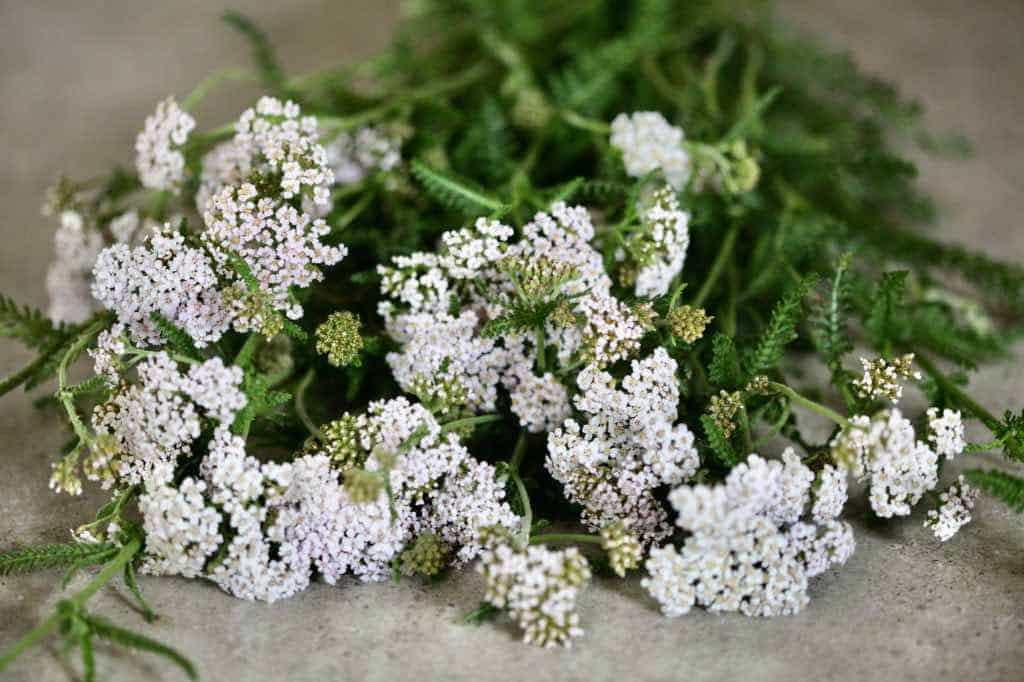
The Leaves
- If you look closely at the leaves of the plant, you will see fern-like leaves with a serrated shape, with many protrusions giving the illusion of many tiny leaves.
- The leaves grow from the flower stalks or stems, and are arranged in a spiral pattern along the stems. Leaves at the bottom of the plant are larger, and gradually become smaller towards the top of the plant.
- This leaf shape helps to easily identify the plant, when it first starts to grow, and throughout the growing season.
- When the plant first starts to grow at the beginning of the season, it is easily identified for its feathery leaves. Even before the plant begins to put up a stem and flower, the young leaves can be found because of their distinctive shape.
- Yarrow is therefore easy to forage, once you can identify the leaf.
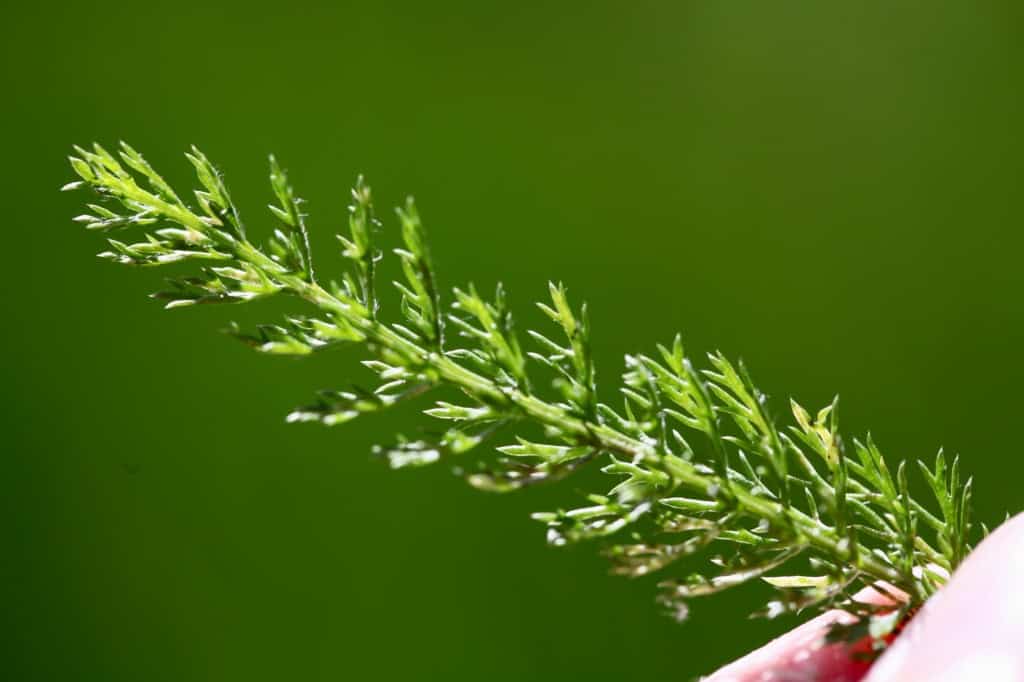
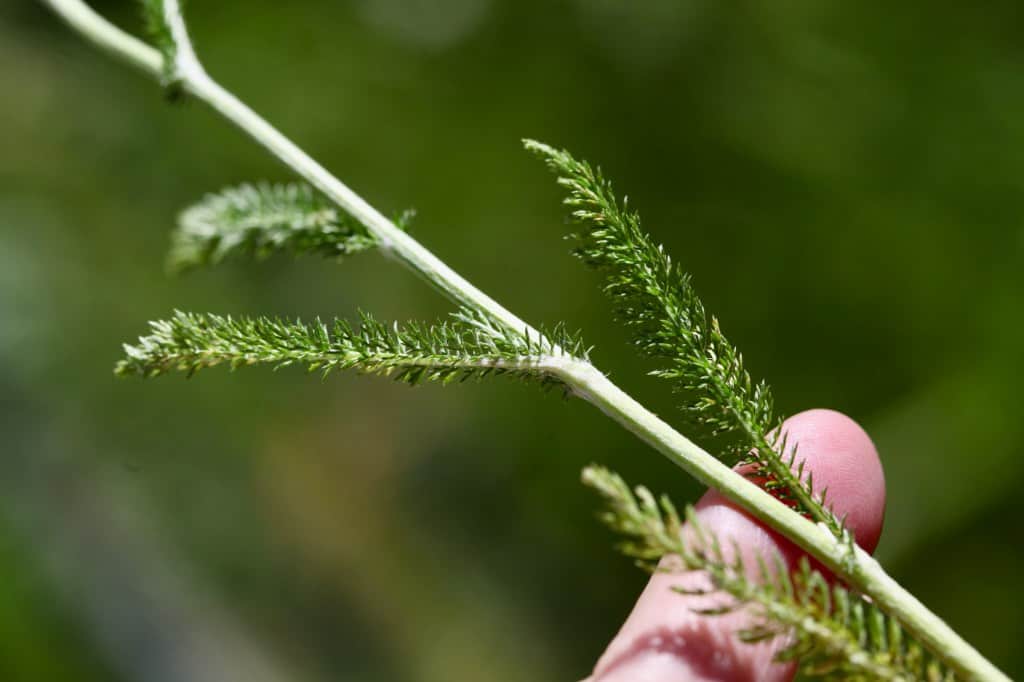
The Flowers
- The flowers of yarrow are disc shaped, with multiple tiny flowers on the flowerhead. The wild flower or common yarrow generally has white, cream, or light pink flowers.
- The small flowers on the yarrow flower head do not open until the yarrow is in full bloom. Prior to this the flowers present as small closed buds.
- The best time to pick the fresh flowers for tea is when they are in full bloom.
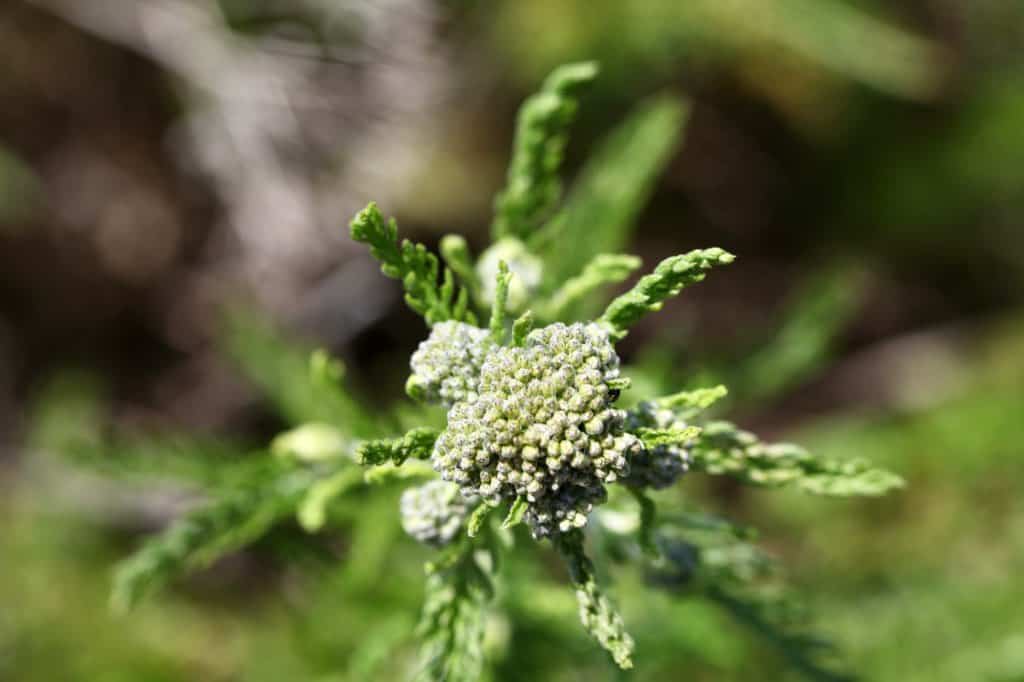
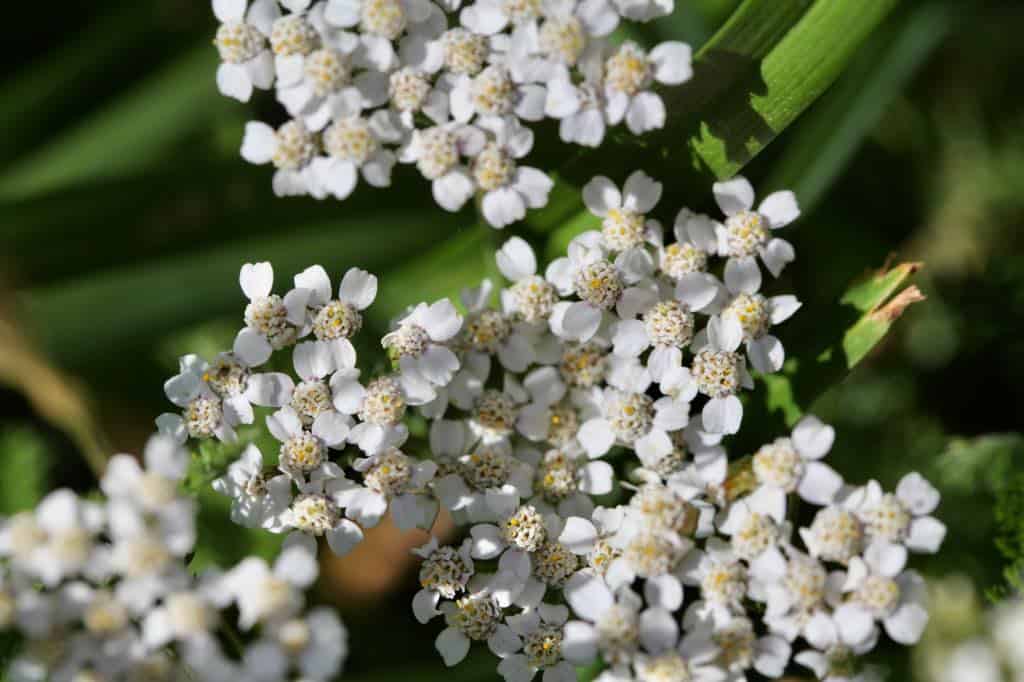
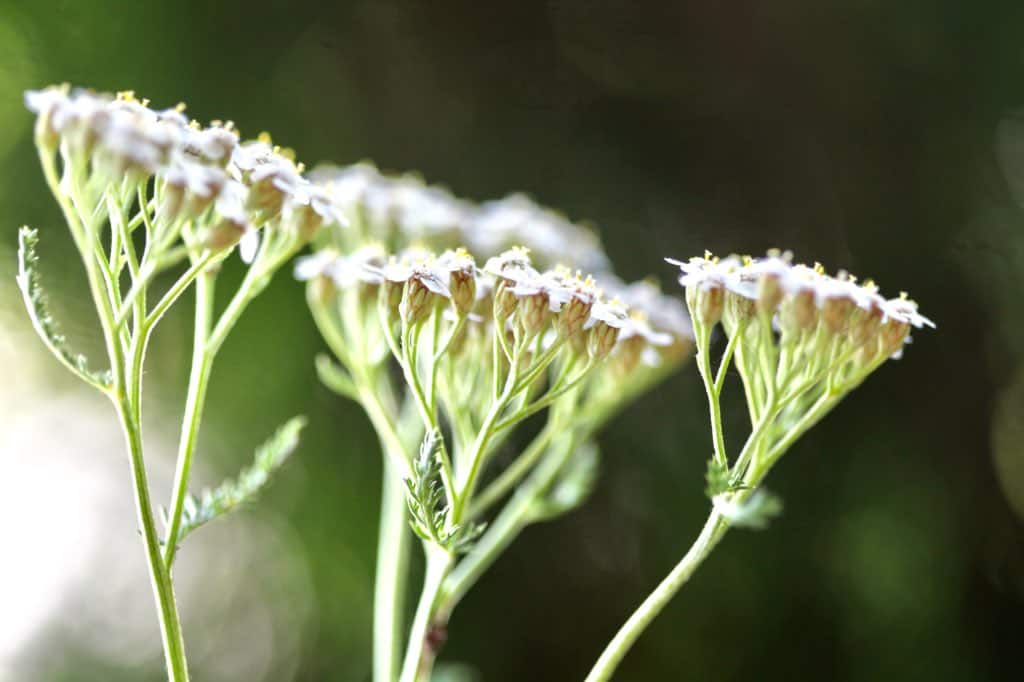
Harvesting Yarrow
Foraging
- If you are foraging your yarrow, make sure to only take a few leaves from each plant, and leave the remaining leaves on the plant for survival.
- The plant is a short lived herbaceous perennial herb, and often returns to the garden or location where it has been growing, year after year.
- In our garden yarrow tends to be biennial, producing lots of leaves and a few flowers the first year, then many large flowers the next.
- Yarrow does easily self seed, which perpetuates the flower's growth in the garden.
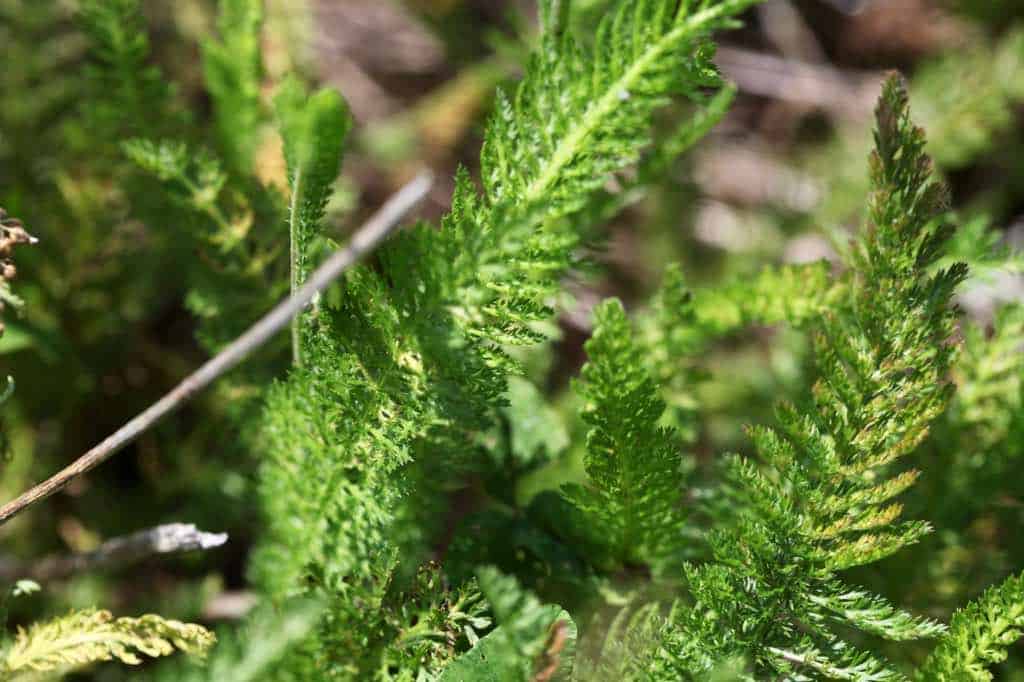
Where To Harvest
- Whenever harvesting plants that you plan to consume, make sure that you choose a location that is free from pesticides and road runoff. An organic location is ideal.
- If you have yarrow growing on your lawn, take note of your neighbour's yard and possible use of herbicides which may drain into your yard.
- I have lots of beautiful yarrow growing on my lawn in town, yet am unable to use it due to my neighbour's herbicide use. We are downhill from the property.
- Luckily we also have lots of yarrow growing at the farm as well.
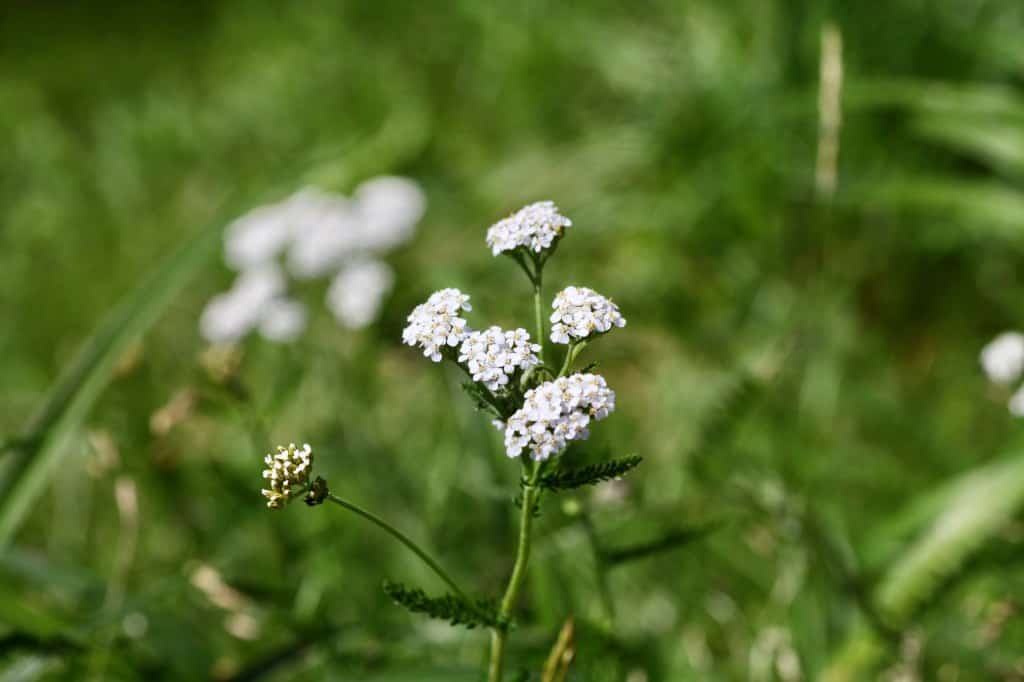
When To Harvest
- Harvest yarrow on a dry day, and after the morning dew has evaporated from the plants.
- A morning harvest is best if possible, as this is the time of the day when the plants will be the most hydrated.
- Harvest the fresh yarrow leaves from yarrow plants at any time during the growth cycle. The flower tops are best harvested when they are in full bloom.
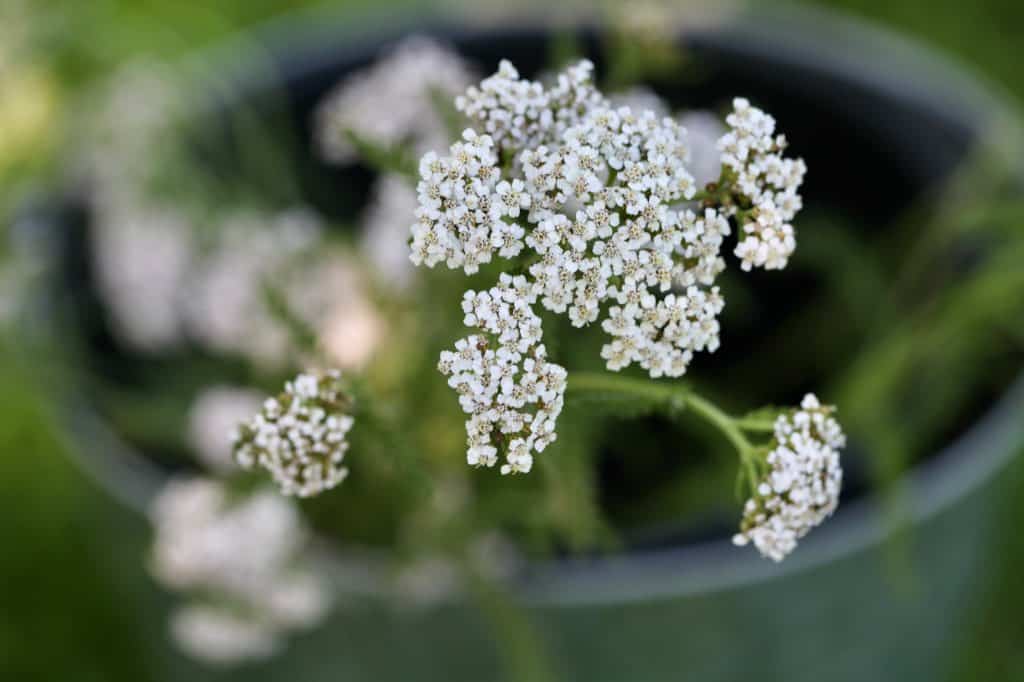
What To Harvest
- You can make an herbal tea from the yarrow flowers, leaves, or both combined.
- Make sure to gather the leaves and flowers when they are in their best condition, regardless of whether you are planning to use them fresh or dried.
- Leave any brown leaves or spent flowers in place on the plant.
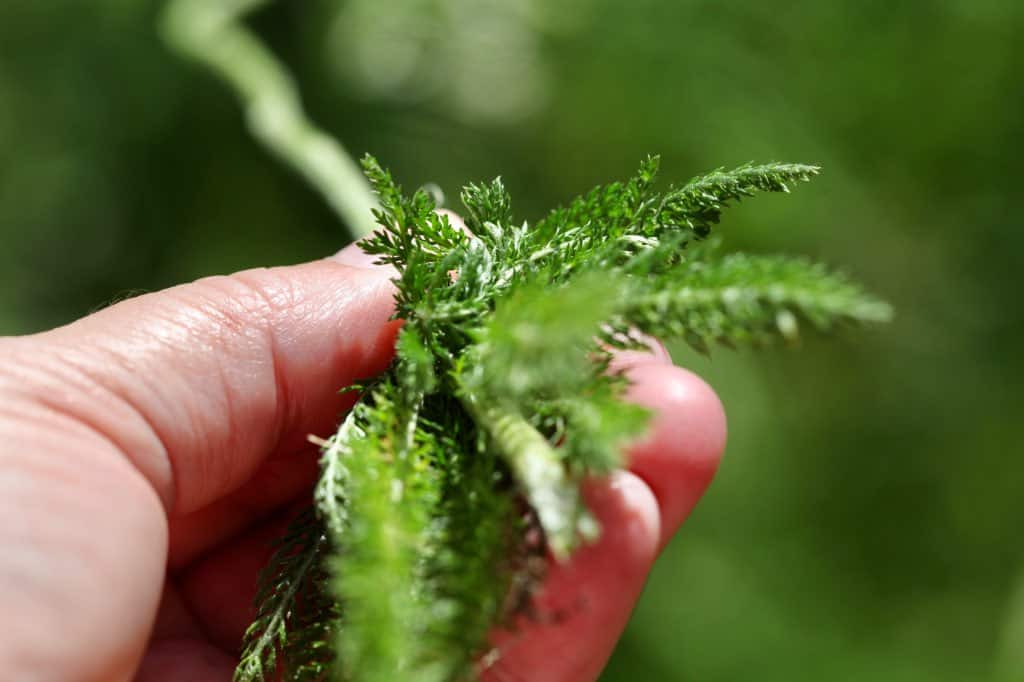
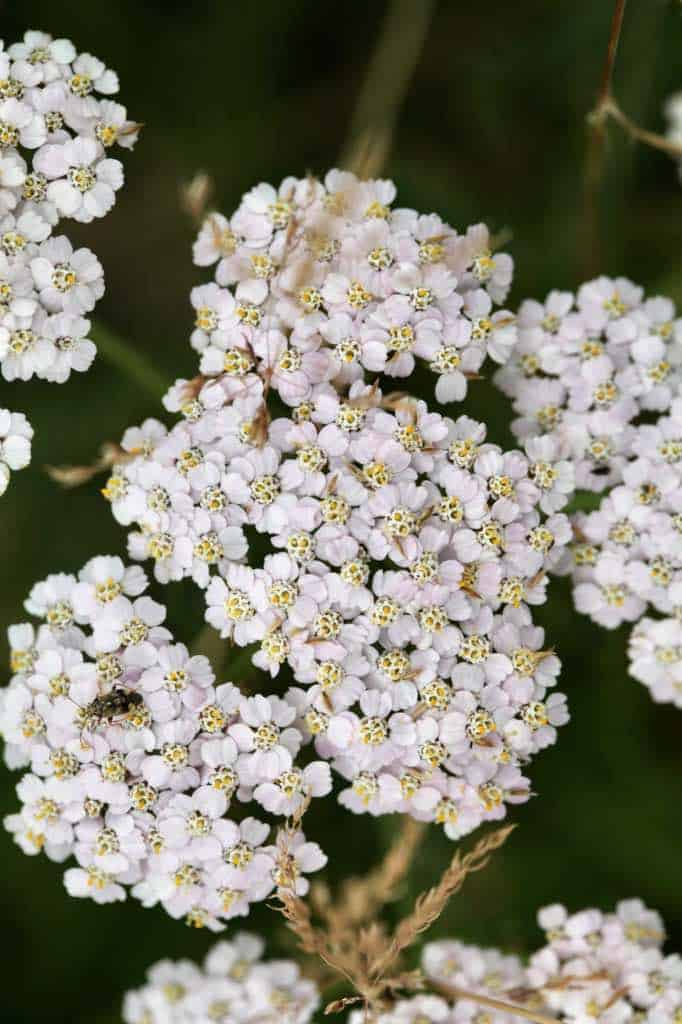
How To Harvest
- Harvest the leaves and flowers of the yarrow plant by cutting them from the stem with a pair of sharp clean scissors or pruners. You can also strip the leaves from the stem with your fingers.
- Again, if you are foraging yarrow leaves for tea, it's important to take care not to strip all the leaves off the plant. Rather, take a few leaves off a number of plants, while leaving the rest of the leaves in place for the plant to grow and use for energy production.
- This also applies to foraging the flowers. Allow some of the flowers to remain in place so that they can set seed and produce new plants.
- If you have grown yarrow in your garden for harvesting, you can harvest the whole plant, or just pick some leaves and flowers, it's totally up to you.
- If you do harvest the whole plant, it can be dried whole and intact by the air drying method.
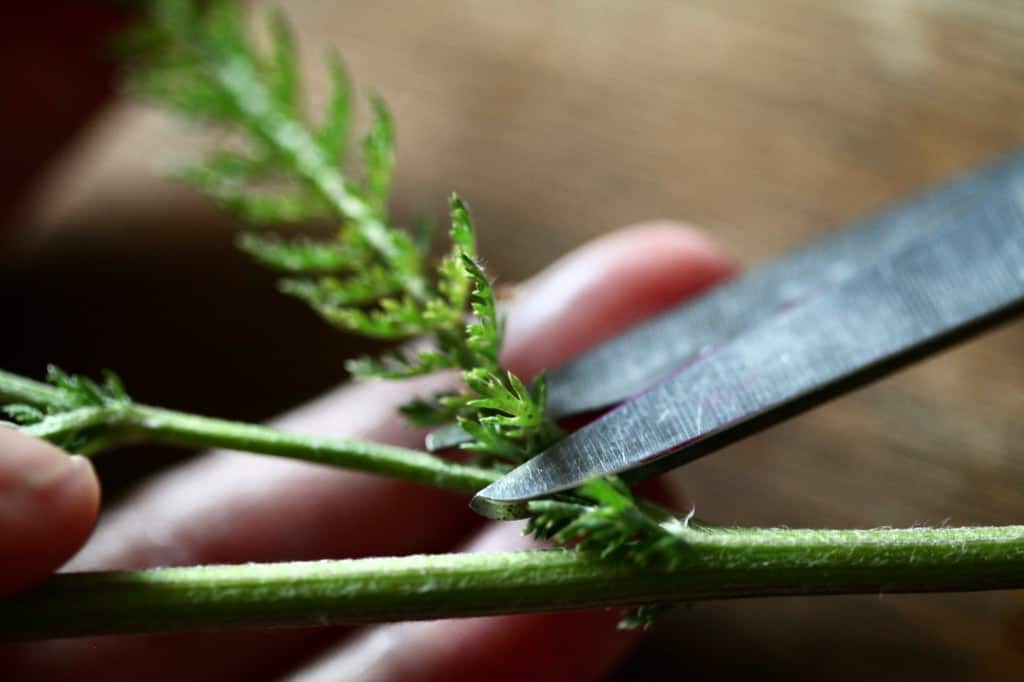
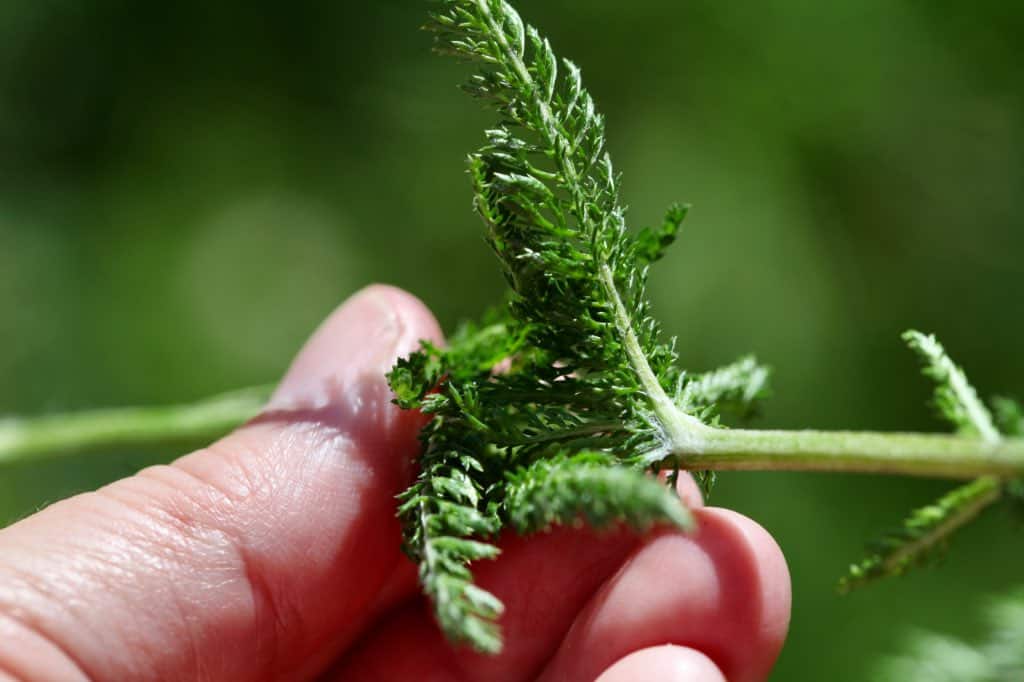
Drying Yarrow
Yarrow is easy to dry using a number of different methods.
Each method works very well, although some are faster than others.
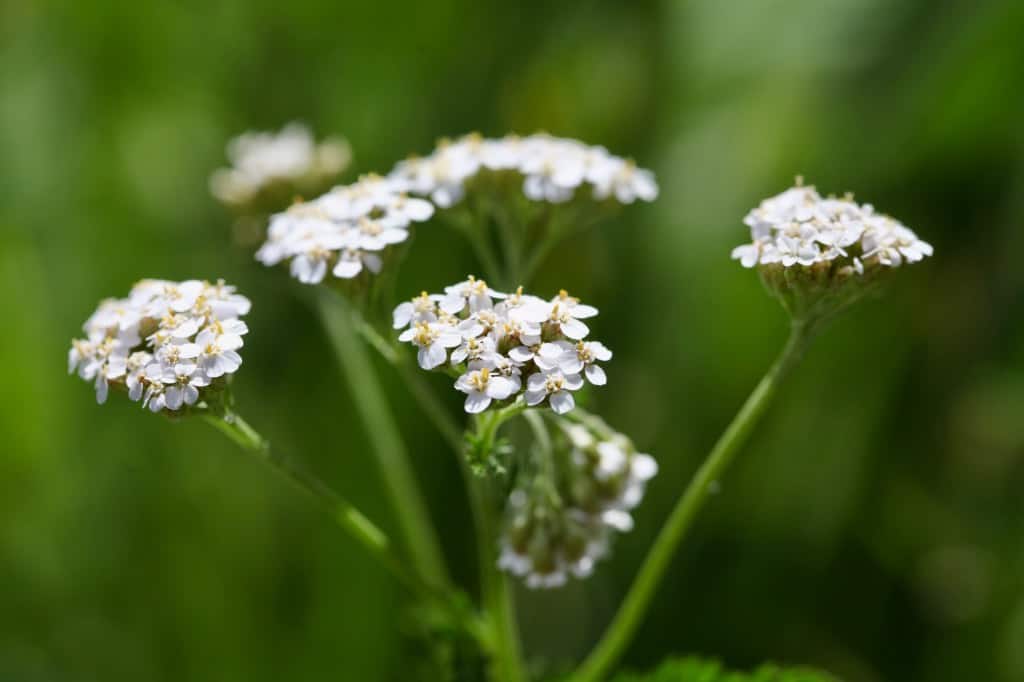
Air Drying
Air drying yarrow can be done in a number of ways.
Placing In A Paper Bag
- You can air dry the leaves by placing the harvested leaves and flowers directly into a paper bag.
- Leave the plant pieces in the bag until completely dried out.
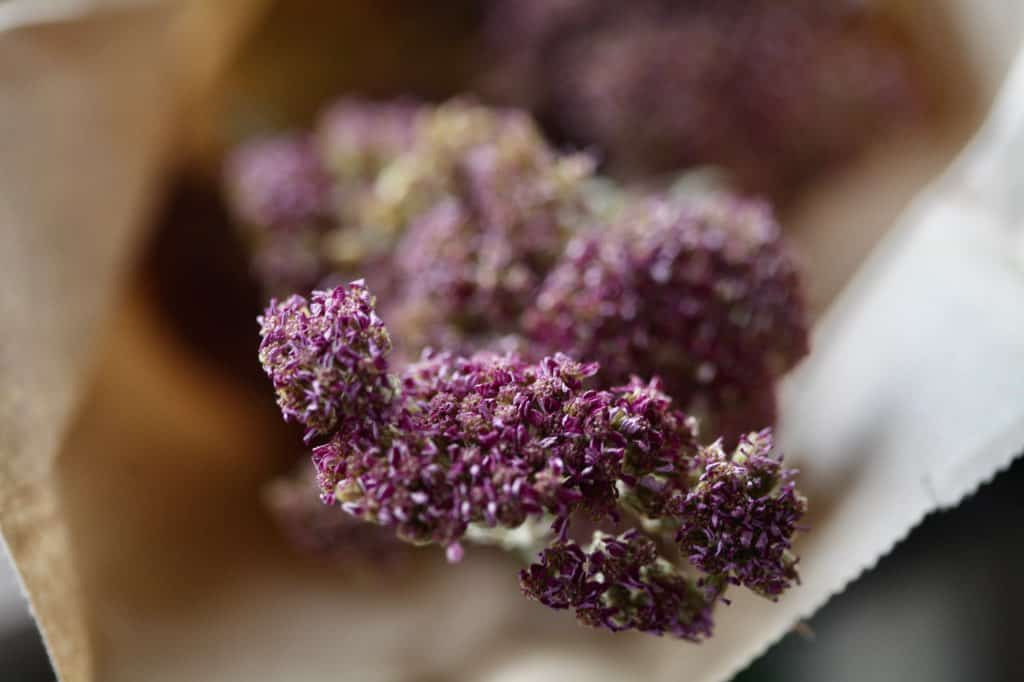
Drying Horizontal
- Alternatively place the leaves and flowers on a surface, such as a plate or baking sheet, and spread the pieces in a single layer.
- Place in a warm and dry location.
- Allow to dry for several weeks, until completely dry.
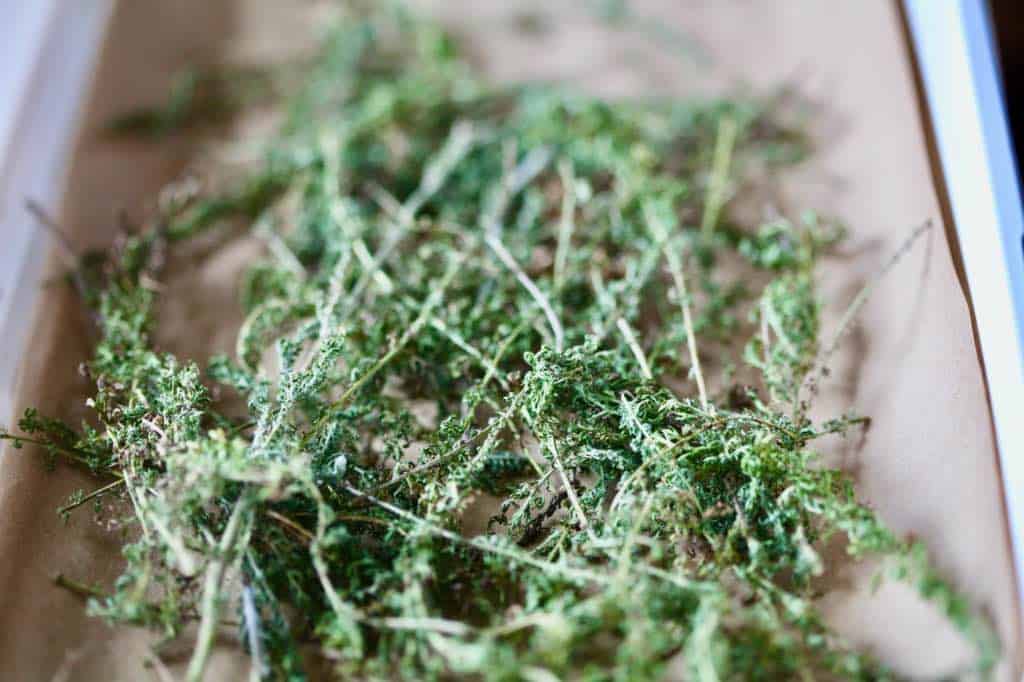
Hanging To Dry
- I also like to air dry the yarrow plants whole, by hanging the plants upside down. Bundle some stems together with an elastic band, and hang in a dry location on a drying line or hook, for several weeks.
- I often hang herbs to dry in my kitchen, on a knob on my hutch. Just make sure that the plants are out of the sunlight, for best results.
- The plant parts will be dry and crispy when completely dry.
- Before storing, strip the leaves from the stems, and place into an airtight container, such as a mason jar.
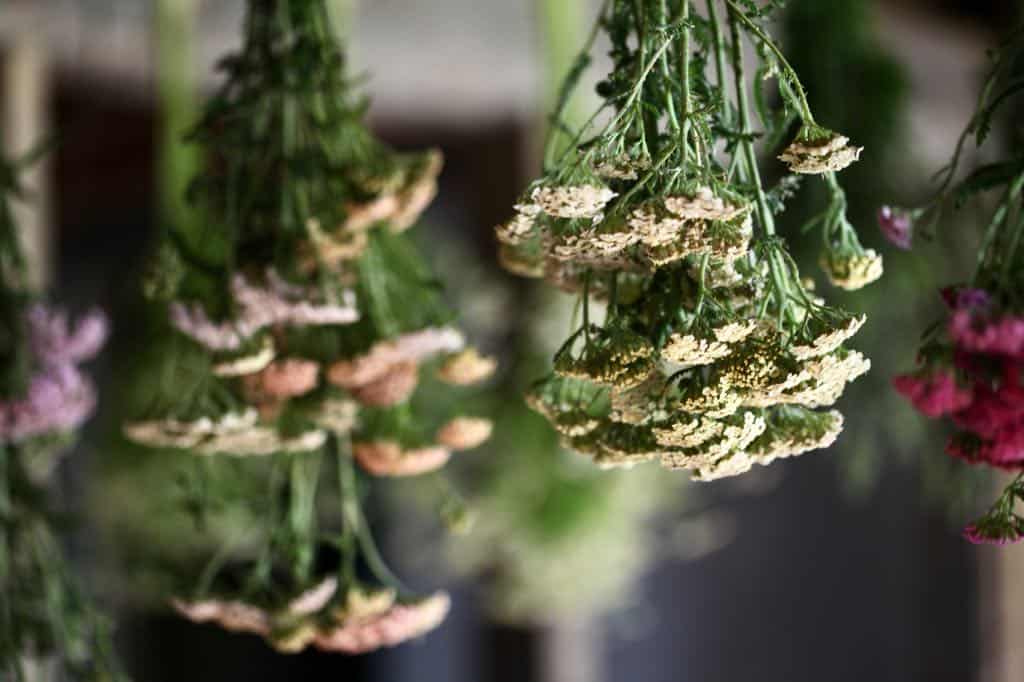
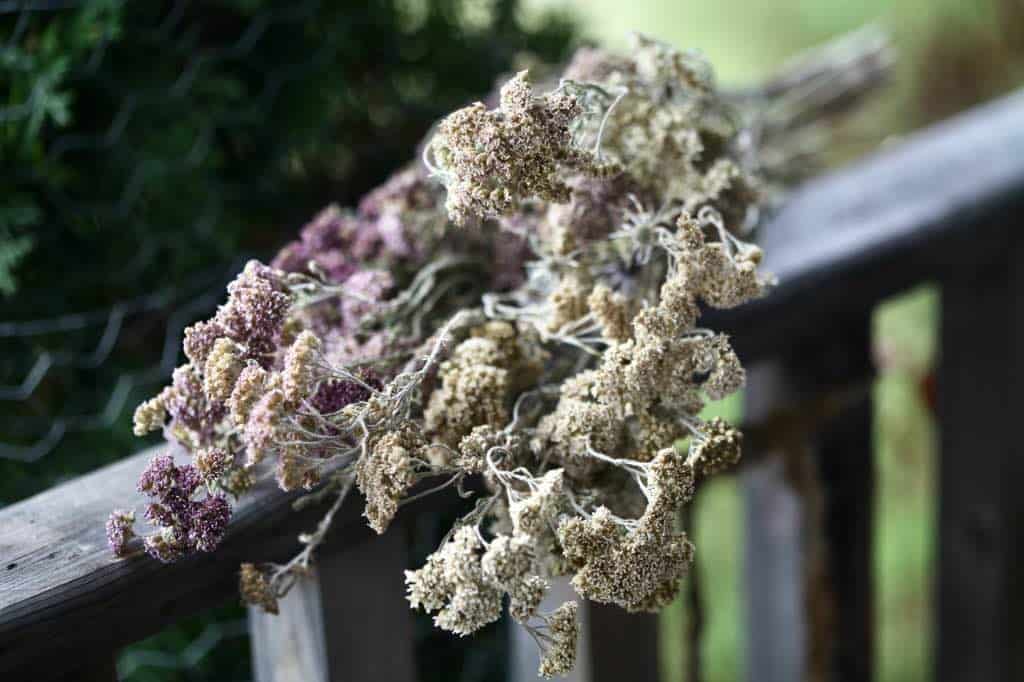
Drying In the Food Dehydrator
- Remove the leaves from the yarrow stem and place on the dehydrator racks of the food dehydrator.
- Dry at the 135°F for several hours, until dry.
- Once dry, the leaves will become crispy.
- Gauge the plant dryness by feeling the crispy leaves. If they need a bit more time in the dehydrator, allow some more drying time.
- Drying time is dependent on individual appliances used, and size of the leaves and flowers.
- When dry, remove from the dehydrator and allow to cool to room temperature.
- Store in an airtight container, until ready to use.
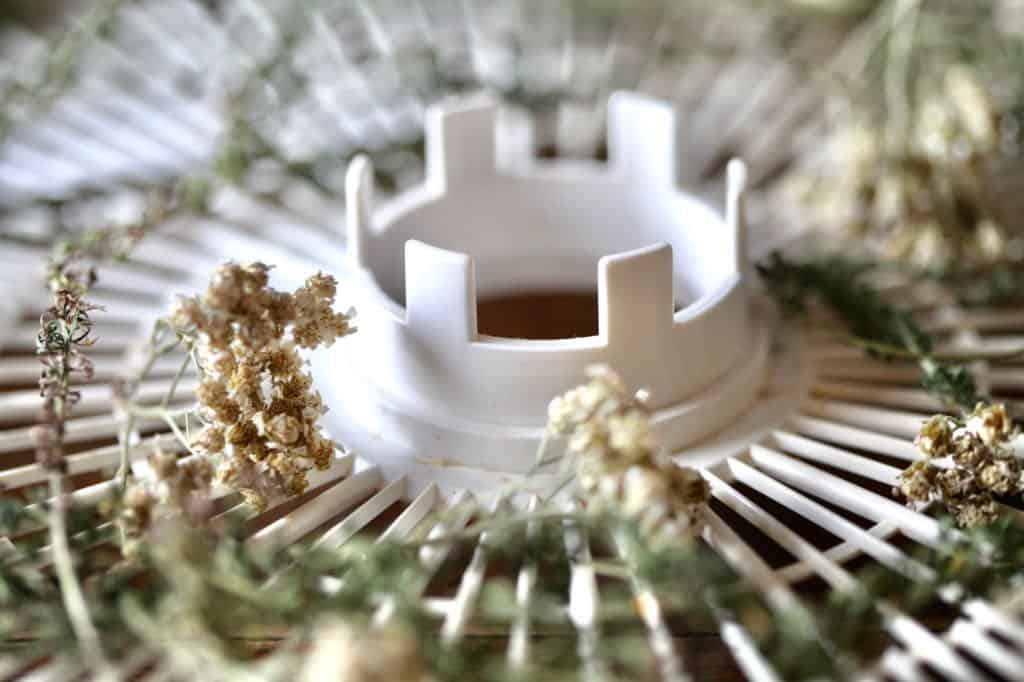
Drying In The Oven
- Drying yarrow in the oven is fast and easy, however make sure that the oven is at it's lowest temperature for drying. You do not want to cook the flowers and leaves.
- Set your oven at it's lowest temperature setting. The lowest setting on my own oven is 170°F
- Arrange the yarrow leaves and flowers on a baking sheet in a single layer, to allow for good air flow.
- Place in the oven for approximately one hour until the plant parts are crispy and dry.
- Once dry remove from the oven and allow the dried yarrow to cool to room temperature.
- Pick out any yarrow stems, then store in an airtight container.
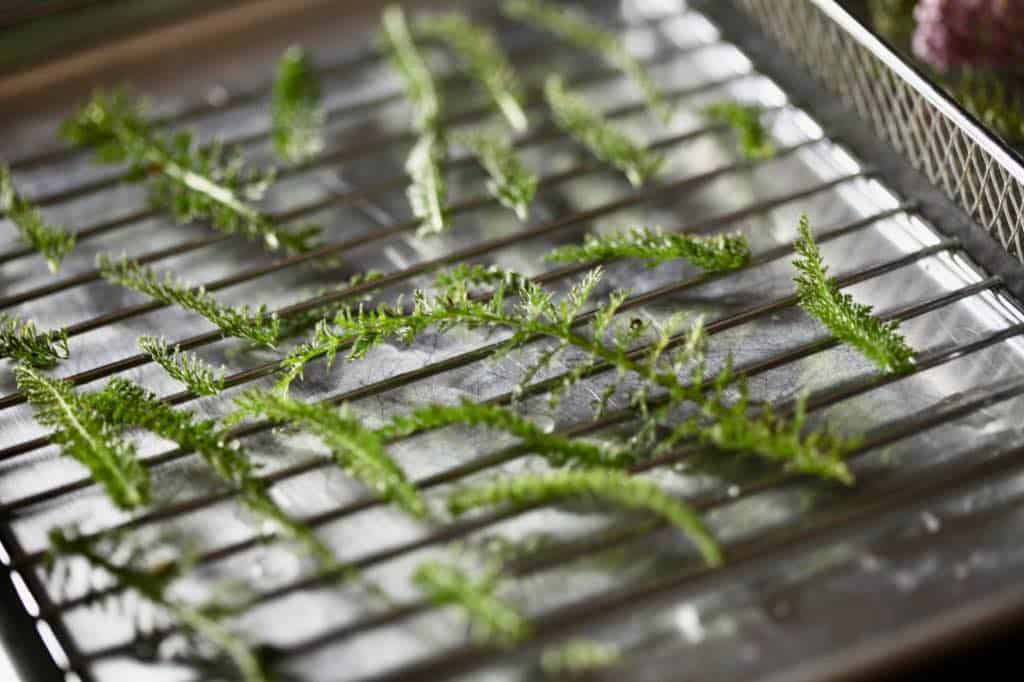
Storing Dried Yarrow
- If you still have a lot of dried stems amongst your dried yarrow, removing the stems will help with the storage space.
- Remove the stems by holding the stem and attached leaves over a container. Grasp the stem between your thumb and forefinger, and pull along the length of the stem.
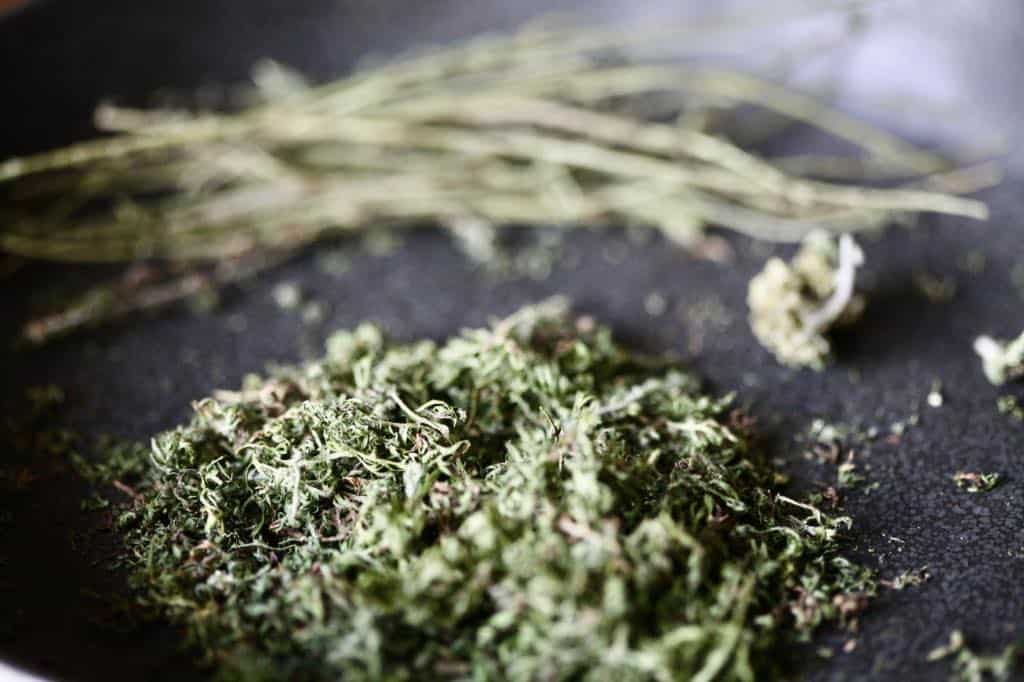
- The leaves are easily removed and will fall into your container.
- Flowers and leaves can be stored together.
- Dried yarrow can be stored in an airtight container and used throughout the year.
- Place the container in a cool dark place for best results.
- Label the jar with the storage date.
- Dried yarrow will store for up to a year with proper drying and storage.
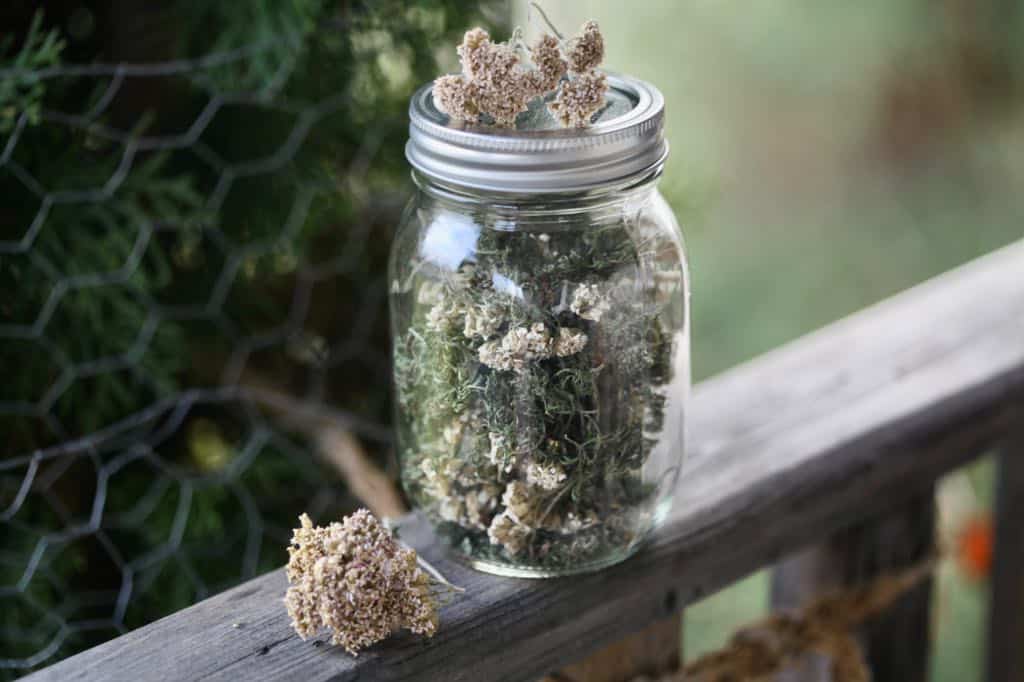
How To Make Yarrow Tea
Yarrow tea can be made with the dried yarrow flowers or leaves. You can combine both together if you wish. The tea can also be made with the fresh plant parts when you catch them in season.
To Make Yarrow Tea:
- For yarrow tea, fill a tea ball or tea bag full of approximately 1 teaspoon of dried yarrow leaves or flowers.
- You can also opt to add the leaves and flowers directly to your cup to make a loose leaf tea. Strain the herbs after steeping.
- Add the yarrow tea to one cup of boiling water.
- Allow to steep for 5 to 10 minutes.
- Enjoy your cup of yarrow tea and the benefits that it will provide.
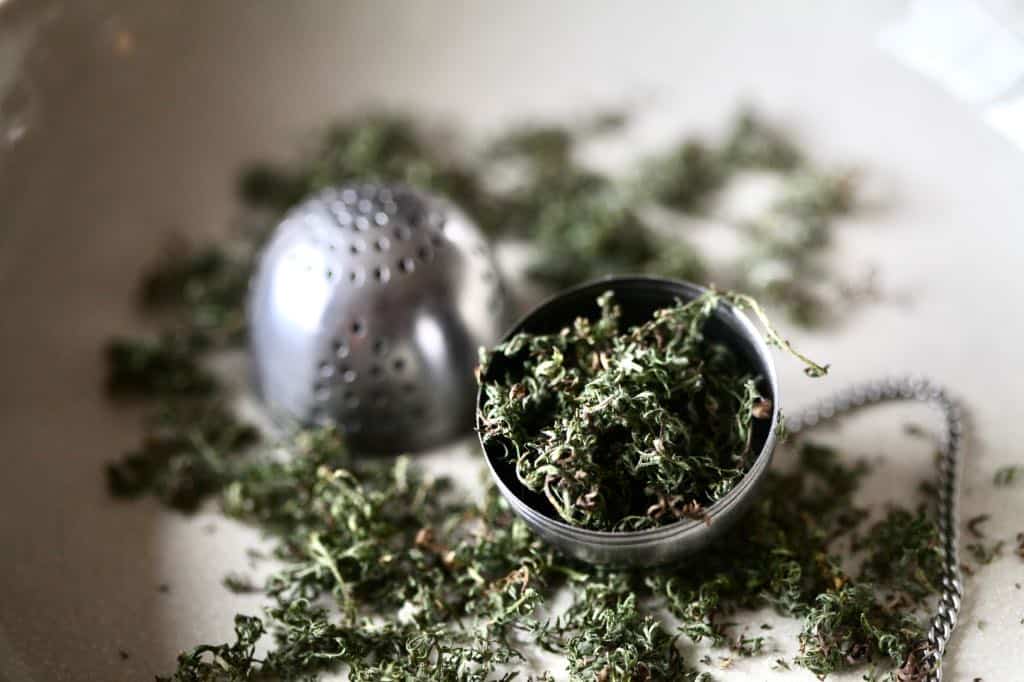
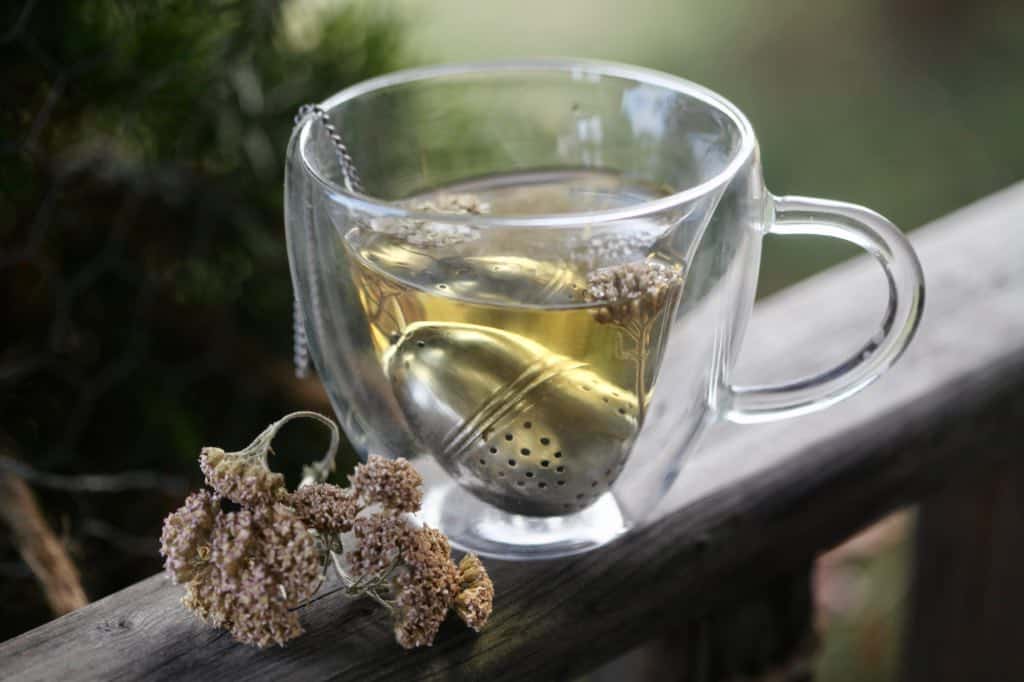
What Does Yarrow Tea Taste Like?
Yarrow tea has a slightly sweet and subtle flavor which is very pleasant to the palate.
It is easy and enjoyable to drink all by itself, without any additives or sweeteners.
I find the tea calming, and familiar.
This most likely has to do with the fact that the tea tastes very much like the yarrow plant smells.
It's a familiar scent that seems to bring me back to my happy place, the flower garden.
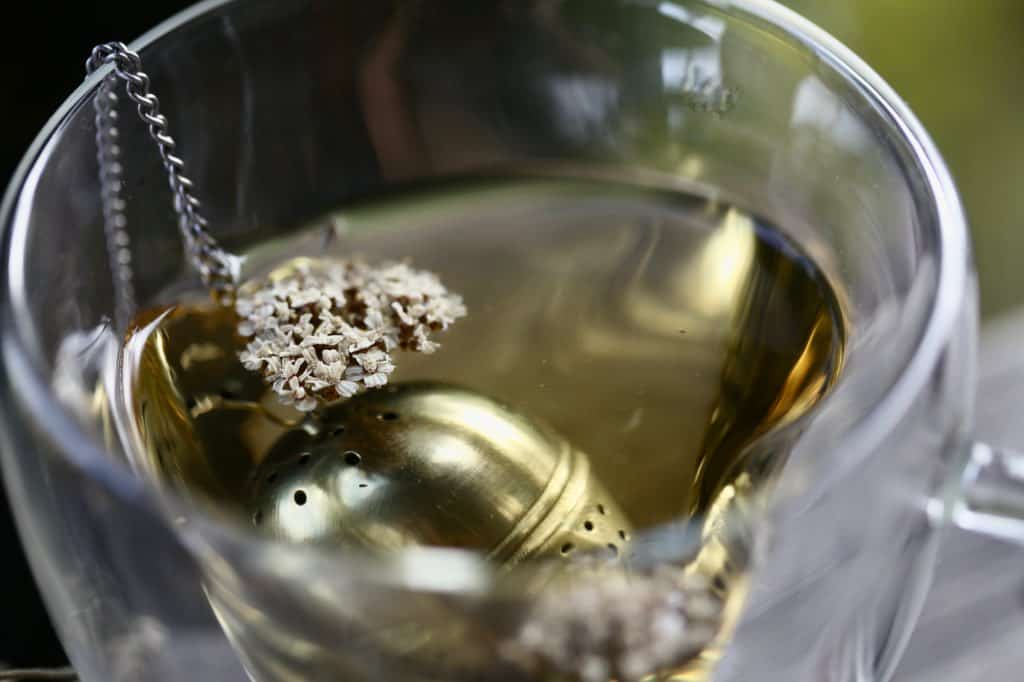
Conclusion
Yarrow has long been valued for it's herbal and medicinal uses.
This common weed and ancient herb can still be used today as a delicious tea.
Yarrow flowers and leaves can be used fresh or dry in a cup of herbal tea.
Having the dried leaves and flowers enables you to enjoy the herbal tea throughout the year, not only when the yarrow is in season.
Harvesting, drying, and storing yarrow for tea is a simple process.
Grow some yarrow in your garden next season. Enjoy the flowers for their beauty, as well as for the herbal benefits that they offer.
Who knows, this common wildflower may even become one of your favorite herbs.
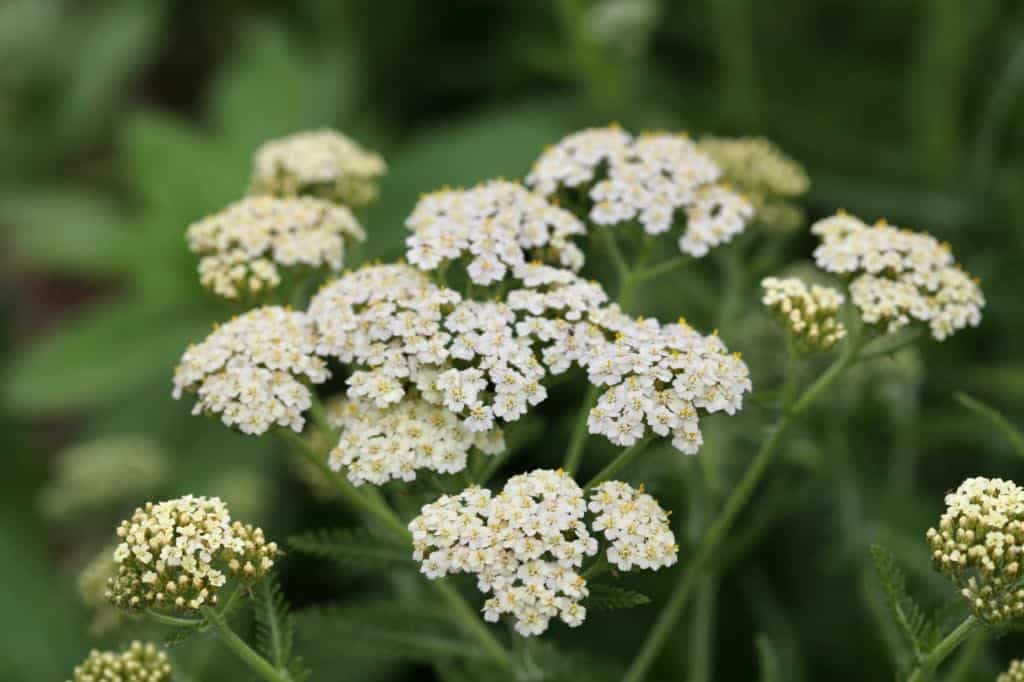
Have you ever tried to dry yarrow for tea? Be sure to leave a comment below to share your experience!
Other Posts You May Like:
See the Web Story on Drying Yarrow For Tea!
PIN IT FOR LATER!
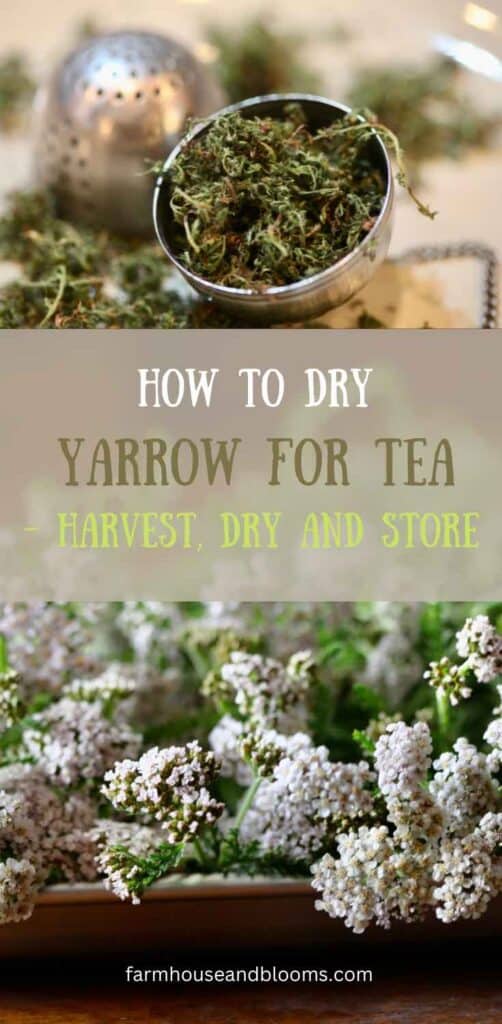
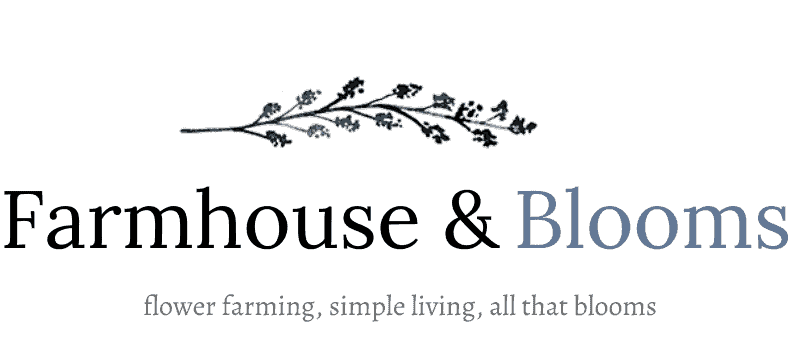

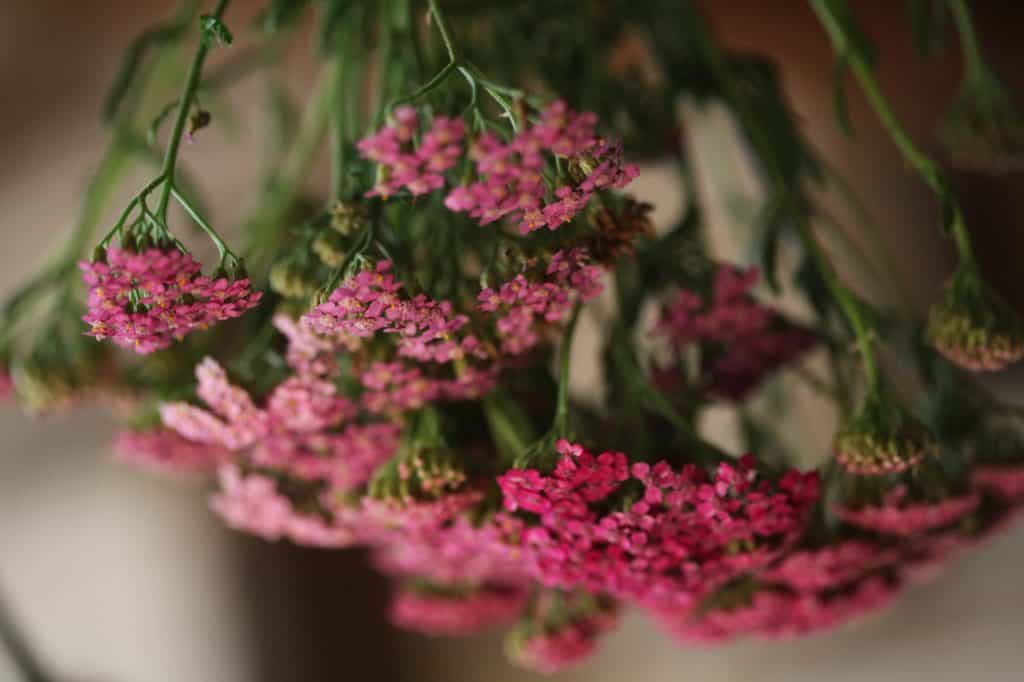
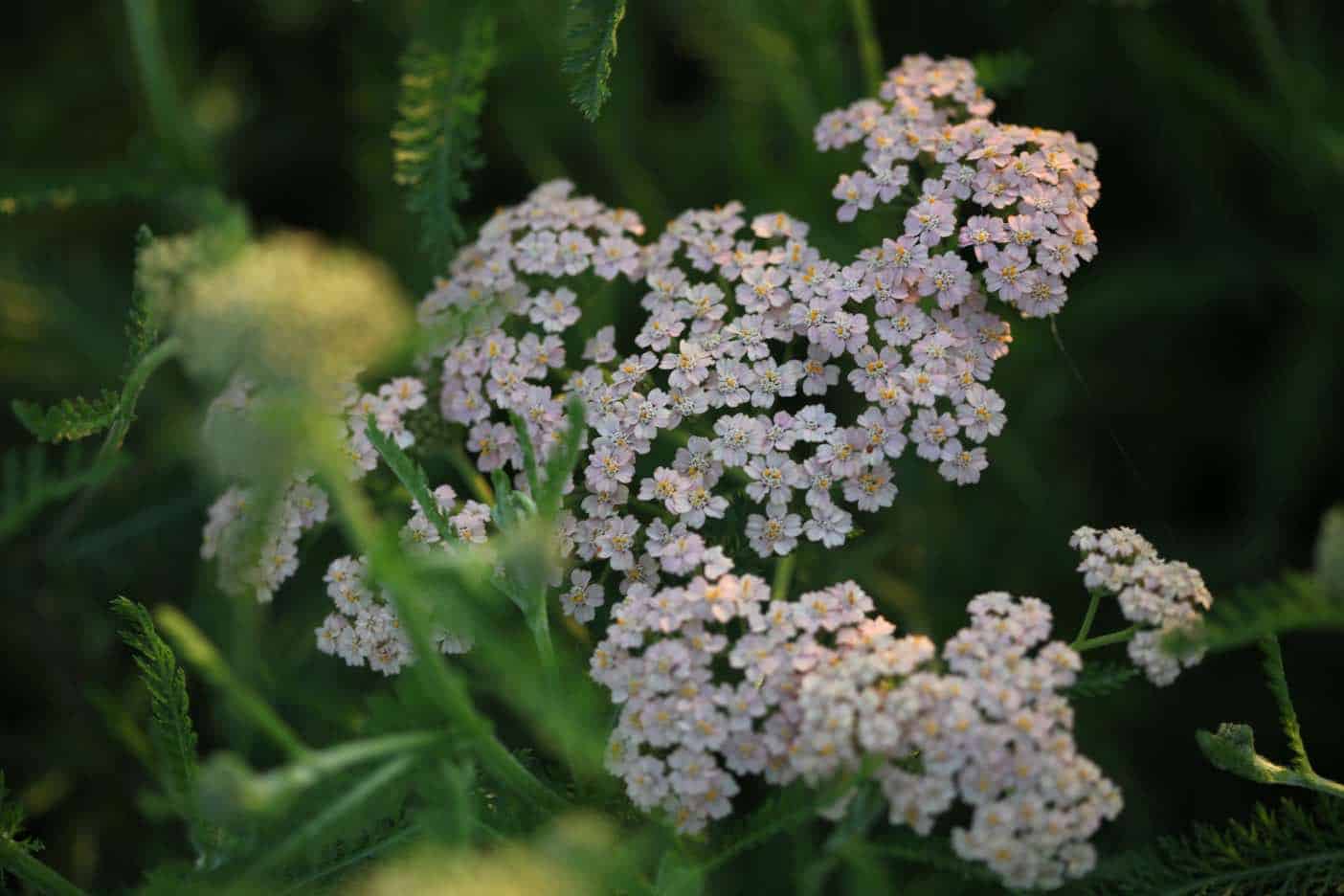
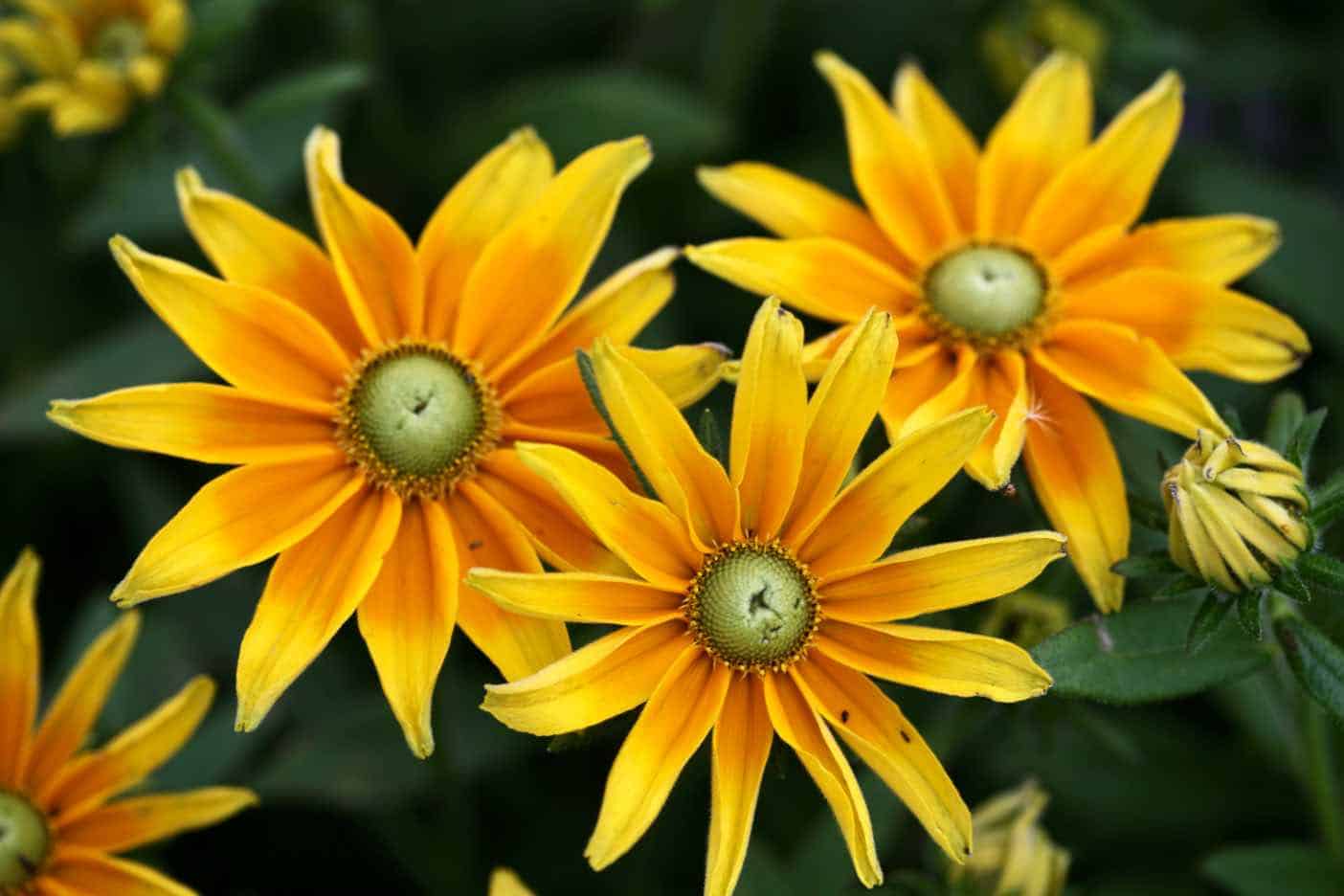

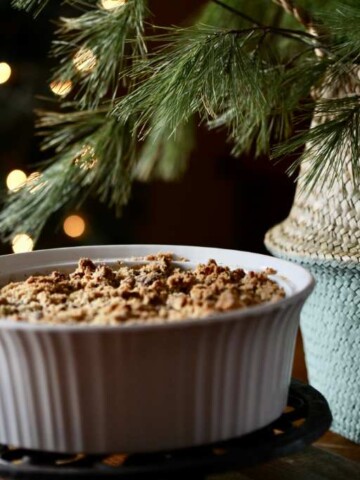
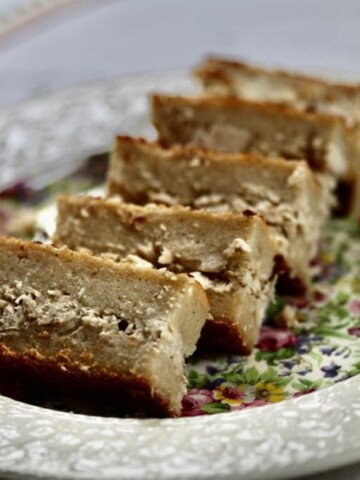
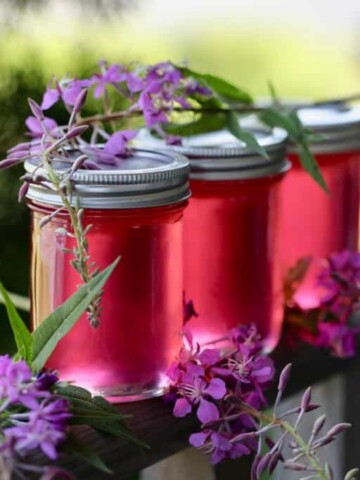
Leave a Reply